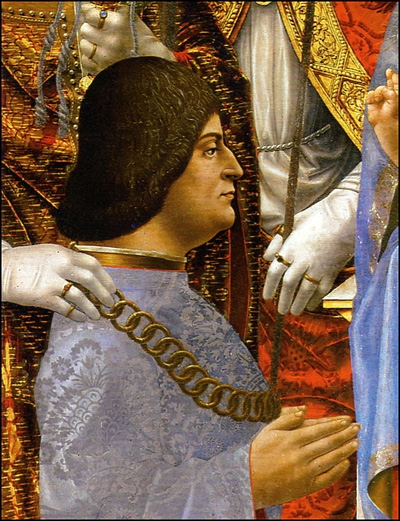Ludovico "il Moro" Sforza
Hertig av Milano 1494-1500. Blev 55 år.

Ludovico "il Moro" Sforza 1452-1508.
Copyright: Engstrand 2013
Far:
Mor:
Född:
1452-07-27 Italien, Lombardiet, Vigevano.
Död:
1508-05-27 Frankrike, Loches.
Äktenskap med Beatrice d'Este (1475 - 1497)
Vigsel:
1491-01.
Sambo med Cecilia Gallerani (1473 - 1536)
Noteringar
Ludovico Sforza, född 27 juli 1452 i Vigevano, Lombardiet, död 27 maj 1508 i Loches (Indre-et-Loire), Frankrike, även känd som Ludovico il Moro (moren) på grund av sin mörka hy. Han var hertig av Milano 1494-1500, Leonardo da Vincis beskyddare och beställare av Leonardos monumentalfresk Nattvarden i klostret Santa Maria delle Grazie.
Ludovico föddes som andre son till Francesco Sforza i Vigevano, som idag är beläget i Lombardiet. Han gifte sig med Beatrice d'Este i januari 1491.
---------------------------------------------------------------------------------------------------------
Leonardo da Vinci söker arbete vid Ludovico Sforzas hov
(in English)
In the early 1480s, many years before he painted the world-famous pieces for which he is now best known—the Mona Lisa being just one—Italian polymath Leonardo da Vinci sought a job at the court of Ludovico Sforza, the then de facto ruler of Milan. A decade later, it was Sforza who commissioned him to paint The Last Supper.
Fully aware that Sforza was looking to employ military engineers, Leonardo drafted an application letter that put his seemingly endless engineering talents front and centre, by way of a 10-point list of his abilities; interestingly, his artistic genius is merely hinted at towards the very end. It is believed that the final document ... translated below, was penned not in Leonardo’s hand, but by a professional writer. The effort paid off, and he was eventually employed.
1. I have plans for very light, strong and easily portable bridges with which to pursue and, on some occasions, flee the enemy, and others, sturdy and indestructible either by fire or in battle, easy and convenient to lift and place in position. Also means of burning and destroying those of the enemy.
2. I know how, in the course of the siege of a terrain, to remove water from the moats and how to make an infinite number of bridges, mantlets and scaling ladders and other instruments necessary to such an enterprise.
3. Also, if one cannot, when besieging a terrain, proceed by bombardment either because of the height of the glacis or the strength of its situation and location, I have methods for destroying every fortress or other stranglehold unless it has been founded upon a rock or so forth.
4. I have also types of cannon, most convenient and easily portable, with which to hurl small stones almost like a hail-storm; and the smoke from the cannon will instil a great fear in the enemy on account of the grave damage and confusion.
5. Also, I have means of arriving at a designated spot through mines and secret winding passages constructed completely without noise, even if it should be necessary to pass underneath moats or any river.
6. Also, I will make covered vehicles, safe and unassailable, which will penetrate the enemy and their artillery, and there is no host of armed men so great that they would not break through it. And behind these the infantry will be able to follow, quite uninjured and unimpeded.
7. Also, should the need arise, I will make cannon, mortar and light ordnance of very beautiful and functional design that are quite out of the ordinary.
8. Where the use of cannon is impracticable, I will assemble catapults, mangonels, trebuckets and other instruments of wonderful efficiency not in general use. In short, as the variety of circumstances dictate, I will make an infinite number of items for attack and defence.
9. And should a sea battle be occasioned, I have examples of many instruments which are highly suitable either in attack or defence, and craft which will resist the fire of all the heaviest cannon and powder and smoke.
10. In time of peace I believe I can give as complete satisfaction as any other in the field of architecture, and the construction of both public and private buildings, and in conducting water from one place to another.
Also I can execute sculpture in marble, bronze and clay. Likewise in painting, I can do everything possible as well as any other, whosoever he may be.
Moreover, work could be undertaken on the bronze horse which will be to the immortal glory and eternal honour of the auspicious memory of His Lordship your father, and of the illustrious house of Sforza.
And if any of the above-mentioned things seem impossible or impracticable to anyone, I am most readily disposed to demonstrate them in your park or in whatsoever place shall please Your Excellency, to whom I commend myself with all possible humility.